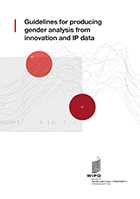
Ms. Beck’s presentation during Panel II: IP economists panel on challenges of measuring and analyzing the gender gap in the IP system of the Americas.
First, they used the UK’s data on education, which allowed identifying women at the different levels of education in STEM, including Bachelor, Master and PhD graduates. They complemented this information by relying on the industry level data to figure out how many women work in these fields as researchers.
Measuring Gender Inequality in Innovation is a well-known challenge. Unlike data on education, patent applications do not disclose the gender of the inventors, making the task of identifying female inventors difficult. Therefore, the team at the UKIPO relied on a UK gender-name dictionary to identify the gender of the inventors in patent applications.
Specifically, the team applied the dictionary to the inventor’s first name field of the EPO Worldwide Patent Statistical Database (PATSTAT). In trying to ascertain the gender of the inventors, the team only assigned gender to inventors when the likelihood of gender is at 90% probability.
The team found that worldwide, women account for the majority of scientist population at the Bachelor and Master’s university degree levels. At the PhD level, this pattern flips with men accounting for the majority of the scientist population. This gender gap continues to widen as the career of the scientist progresses, culminating in men representing almost 90% of inventors in patent applications.
However, the picture is improving. In 1998, women accounted for 8% of patent applications in the UK. This figure rose to 11% in 2017, showing a steady improvement over time.
Other results from this analysis:
- Between 2013-2017, only 6% of inventions were composed of all-female teams compared to 69% of that were all-male. These included sole inventorships for both genders.
- On mixed teams, there are on average one woman for 2.4 men.
- In 2017, women inventors accounted for 13% of patent applications globally, doubling in the last 20 years. At this rate, by 2070 there would be gender parity.
- The top technologies with female participation (of around 50%) are biotechnology, pharmaceuticals and chemicals.
- The lowest participation occurs in machines, engines and transport (10% of participation).
Some limitations to their study are:
- Western bias. They used birth name data from the United Kingdom and the US.
- Unisex names were not disambiguated.
- Name-gender matching can be time sensitive.
- Gender was accounted only as a binary variable.
Do you want to learn more about UKIPO’s methodologies and results? Check their full report on Gender profiles in worldwide patenting: An analysis of female inventorship.
Other stories you may enjoy

In Canada, 1 in 8 AI Inventors is a Woman
There are several ways to get innovation and IP data with gender breakdown. Check which one suits your case better.

How to Create Innovation Gender Indicators – The Chilean Way
There are several measures of gender gaps in innovation. However, choosing the “right” indicator depends on the purpose. Here are some suggestions on what to consider when choosing the type of indicator.
Related resources

Guidelines for producing gender analysis from innovation and IP data
Understanding how women and men can access and use the intellectual property (IP) system equally is key to ensuring that their ingenuity and creativity translates into economic, social and cultural development. This short guide summarizes best practice for producing innovation and IP gender indicators.
